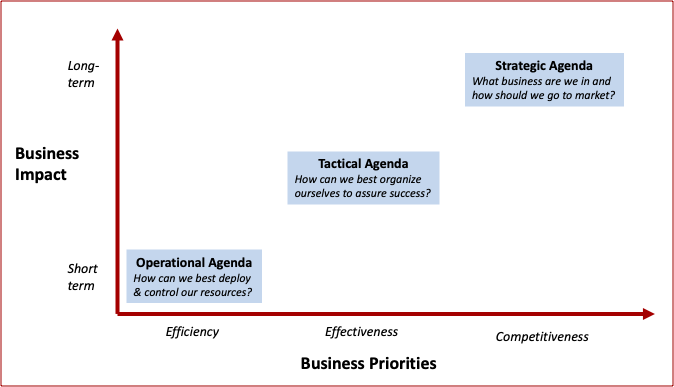
Organisations need to address three different management agendas – often simultaneously. In any given enterprise, however, one of these agendas is likely to prevail at a particular time, depending on the business situation. Enterprise architecture has a different role to play in addressing each of these agendas, so although the skills required are common, it is important to ensure that the work of the enterprise architecture function is aligned with business priorities.
- The Operational Agenda – This management agenda comes to the fore as a typical response to deteriorating trading conditions. Action is required in the short term. The focus here is on improving the efficiency of existing business functions and processes, eliminating superfluous activities, seeking cheaper sourcing options, and generally cutting costs.
The priority for enterprise architecture should be to enable a clear understanding of those existing business and IT capabilities (functions, processes, applications, databases and technology platforms) where rationalisation opportunities and cost savings are most likely to emerge. A broad-brush view of the current state may be all that is needed to highlight the most promising areas. Once the targets have been selected, sufficient detail will be needed to help ensure that the consequences of taking action are clear.
Without such a detailed view, change initiatives may run into unforeseen problems. One major bank we worked with claimed to be running many hundreds of servers that were probably redundant, but their actual purposes were so uncertain that nobody dared to turn them off.
- The Tactical Agenda – With a medium-term time horizon, this management agenda is typically set in response to competitive or regulatory pressures. The focus is on improving the effectiveness of the organization by restructuring business activities and enhancing current business processes in selected areas.
The emphasis here is on continuous improvement. This agenda should be supported by architectural views of existing business and IT capabilities cast at a level of detail sufficient to provide a reliable baseline for change. It also requires views of the modified future business operating model that show exactly how and where the changes will have their impact.
- The Strategic Agenda – This management agenda, which has a long-term time horizon, is set in response to actual or predicted changes in market conditions, and for a company, the focus is on future competitiveness. The main requirement of enterprise architecture is to provide a clear articulation of the future vision of the enterprise in the form of an operating model that may be radically different from the current state.
This future view is likely to be expressed at a high level initially, but it will be refined over time as the design of the future state evolves. In some cases it may be appropriate to produce more than one future state model. This will apply where multiple business scenarios need to be played out.
The strategic agenda also requires a view of the current operating model, but only at a level of detail necessary to provide a reliable baseline for costing the change programme, for judging which existing organisational assets might be deployed to support the future model, and to develop a viable migration strategy.
Managing the different operational, tactical, and strategic agendas in play at the same time is a complex task. It requires a combination of vision, planning, collaboration, and continuous monitoring and adjustment. The enterprise architect plays a critical role in ensuring that all agendas are aligned so that the organisation achieves its goals and objectives, while the current business situation is understood and addressed.